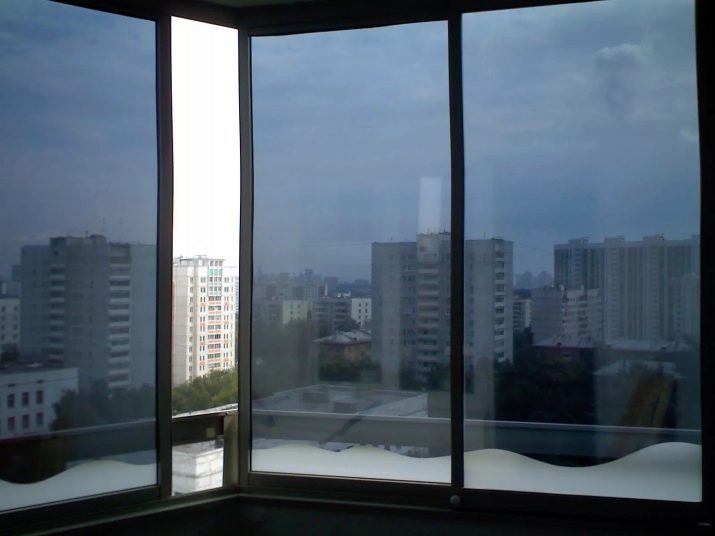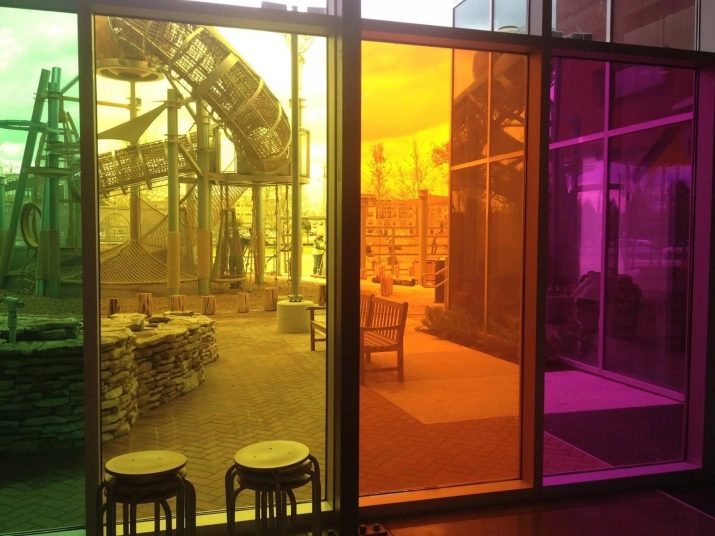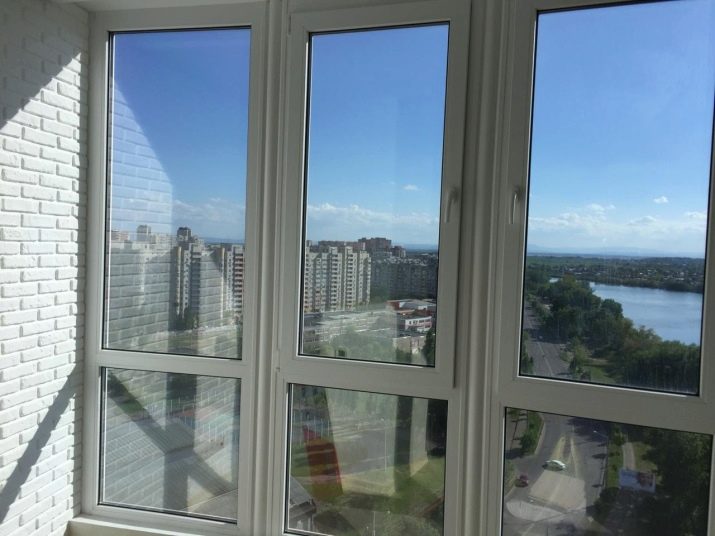Being on the balcony or loggia is always a joy, but on a hot sunny day this can be a real problem, because the air becomes hot, and even open windows do not save. You can solve the problem by setting the tint on the glass. What it can be, the main advantages and disadvantages of the method, as well as selection tips, we will consider in our article.




Features
Window tinting is becoming increasingly popular among owners of balconies, and not only. This coating can often be found on the facades of buildings made of glass, shop windows, as well as car windows.

It is most often based on multi-stage polyester, then processed into tint. This layer as a result is homogeneous and very thin.


It should be noted that not all tint films can boast of high quality.
This indicator is primarily affected by the purity of the raw materials. In the modern market there are several manufacturing companies that have earned their reputation by hard work and producing good coverage.

Tinting has several layers. Each of them has its own function. For example, the protective layer helps to prevent abrasion of the coating, protects from exposure to sunlight and high temperatures. In some cases, metal is used in the manufacture of the tint coating.
It is worth considering that its layer, having a thickness of only 1-2 molecules, will help to increase the reflective abilities and thermal characteristics of the product.


Advantages and disadvantages
You can stick a tint film for glass on the balcony and loggia in any apartment. With its help, first of all, it will turn out to reduce lighting. This is especially true when it comes to about the location of the windows on the sunny side.

Here, artificial dimming is a real salvation. Windows tinted have their pros and cons. Let's consider them in more detail.

Among the advantages, it can be noted that tinting does not require careful care, as in the case, for example, when the windows are closed by wrinkled and dirty curtains. Dust cleaning is easy. Besides, space is saved, which is especially important for small balconies. The use of fences can significantly reduce it.

Toning will last a long time. Direct sunlight does not harm her. Also, unfavorable weather conditions, such as rain, wind, heat or frost, are not terrible for her. The room will be protected from ultraviolet radiation and bright light.
When choosing a tint film, you need to consider the needs of the owners of the room.
For example, with its help it is possible to achieve that from the street it will be impossible to look inside. This is especially important for residents of lower floors. In addition, you can significantly increase the strength of the surface. Also, the use of a film gives scope for imagination and the ability to design a balcony in various versions.

However, it would be dishonest not to say that this type of coating also has disadvantages.
One of them is the constant dimming of the apartment. In some cases, this leads to the fact that it is impossible to do without artificial lighting. In cases where tinting makes the windows impenetrable from the outside, but at the same time has the ability to transmit light well, there is a high probability of dim lighting. Especially these nuances are noticeable in cloudy weather, when an additional darkening of the room is created.

Kinds
So, if it was decided to tint the windows on the balcony, you need to determine the type of material that will be used in the work. It should be noted that the choice here is quite wide, it all depends on the destination.
The main variety is considered to be sunscreen. Its advantage is that it has the ability to retain up to 9 percent of ultraviolet radiation. This prevents furniture from fading due to sunlight. In addition, it not only helps maintain an acceptable temperature regime on hot sunny days, but also makes it possible to retain heat on the loggia in the winter.

Perfect for restricting visibility from the outside. mirror coating. It allows viewing only from the inside, respectively, the street will be freely visible from the balcony, but the effect of a mirror is created from the outside. In addition, condensation does not accumulate on the surface. Also, the room is closed from harmful radiation.
When choosing this type of coating, it is necessary to determine the degree of strength - it can be any, and the most resistant options can protect the surface even in the event of an explosion.

Residents of lower floors often choose a protective film for use. It should be noted that any tinting significantly increases the strength of the glass, but the protective option is also fireproof. If panoramic windows are located on the balcony, it makes sense to use shockproof film. In this case, the owners of the premises can be sure of the reliability of the coating, which will well tolerate external influences.

You can’t stop at decorative tint film. It can not only be made in various color options, from white to black, but can also have patterns and images on the surface. You can choose both glossy and matte finish. However, this variety has the ability to pass harmful ultraviolet light, so it should be considered solely as a decorative option.

If the room has stained glass or panoramic windows, it makes sense to consider their tinting using architectural cover. Its peculiarity is that both sun-protection and protective properties of the material are combined here.
In this situation, it is necessary to take into account design wishes. The interior, as well as the appearance of the outside of the balcony, can turn out to be very unusual.

An interesting option are energy-saving tint coatings. They are designed to reflect infrared radiation. Such a film acts on both sides. On hot sunny days, it will help to reflect thermal energy, while in winter it will retain heat inside the balcony, without letting it out.

Finally, it is impossible not to say about a fairly new type of tinting, called "Athermal film." At first, they were suspicious of him on the market. The fact is that such a film is transparent, while retaining 100 percent ultraviolet radiation and up to 60 percent heat.
It is the best option for those who care about maintaining lighting indoors.

Tinting material can be removable. In some cases, this is very convenient, because it becomes possible to adjust the level of illumination depending on the time of year. Sometimes you can focus even on the time of day. Wherein All coating qualities are maintained.

DIY installation
Installation of the film must be carried out in warm weather, at a temperature of +10 to +35 degrees. Before work is necessary Rinse and degrease the surface properly.
It must be borne in mind that dust and small debris can subsequently cause detachment.
To install, you will need:
- degreaser;
- sprayer;
- sharp knife;
- lint-free matter;
- rubber spatula.

The film must be cut into the necessary parts. After that, the adhesive side and the surface itself are sprayed with water. Glue the material from top to bottom, gradually smoothing it with a spatula and cloth so that there are no bubbles. If the glass from the frame can be removed, this will facilitate the work. In this situation, tinting should be taken with a small margin, so that then you can trim the edges.

Selection tips
When you already have an understanding about the structure of the required film and its characteristics regarding energy saving, you need to decide on the light transmittance. Usually this indicator is noted in percent. He talks about how much light will get inside.
The more sun affects the object, the smaller this figure should be.

Next, you need to decide on the color. The color gamut of films is presented on the market in a huge assortment. This characteristic is directly related to the light transmittance of the canvas, and in addition, affects the perception of the interior as a whole, so it is necessary to consider various options.


Experts recommend abandoning the purchase of cheap materials of dubious quality. The fact is that the coating in this case may turn out to be uneven, and during dismantling, serious problems often arise. It is worth paying attention to the products of attorney manufacturers.

Care
This material is not difficult to care for, but you still need to keep it in order. At the same time, care must be taken not to damage the surface, so there are some nuances of caring for the canvas. The main thing is not to use hard brushes that can damage the film.

It is recommended to wash a surface only with a delicate detergent. Soap solution is perfect. The procedure should be carried out using a soft sponge. Wet cleaning will be required monthly.
In the event that a bubble appears on the surface, it must be carefully filled with water through the needle of the syringe, and then ironed with a soft cloth. This will allow water to be displaced, and the film will again adhere to the surface.

In the next video, you will learn how to make a removable tint of the balcony yourself, without the help of specialists.










